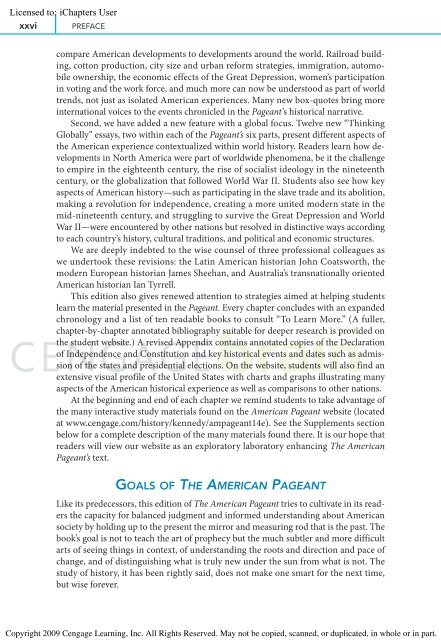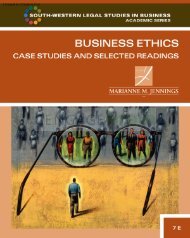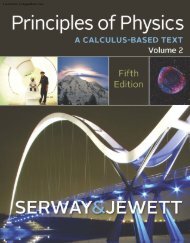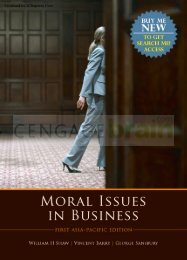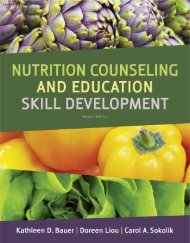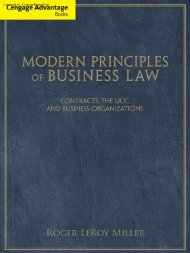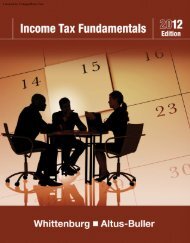03469_00_FM_pi-xxxii pp2.indd - CengageBrain
03469_00_FM_pi-xxxii pp2.indd - CengageBrain
03469_00_FM_pi-xxxii pp2.indd - CengageBrain
You also want an ePaper? Increase the reach of your titles
YUMPU automatically turns print PDFs into web optimized ePapers that Google loves.
Licensed to:<br />
xxvi PREFACE<br />
compare American developments to developments around the world. Railroad building,<br />
cotton production, city size and urban reform strategies, immigration, automobile<br />
ownership, the economic effects of the Great Depression, women’s participation<br />
in voting and the work force, and much more can now be understood as part of world<br />
trends, not just as isolated American experiences. Many new box-quotes bring more<br />
international voices to the events chronicled in the Pageant’s historical narrative.<br />
Second, we have added a new feature with a global focus. Twelve new “Thinking<br />
Globally” essays, two within each of the Pageant’s six parts, present different aspects of<br />
the American experience contextualized within world history. Readers learn how developments<br />
in North America were part of worldwide phenomena, be it the challenge<br />
to em<strong>pi</strong>re in the eighteenth century, the rise of socialist ideology in the nineteenth<br />
century, or the globalization that followed World War II. Students also see how key<br />
aspects of American history—such as participating in the slave trade and its abolition,<br />
making a revolution for independence, creating a more united modern state in the<br />
mid-nineteenth century, and struggling to survive the Great Depression and World<br />
War II—were encountered by other nations but resolved in distinctive ways according<br />
to each country’s history, cultural traditions, and political and economic structures.<br />
We are deeply indebted to the wise counsel of three professional colleagues as<br />
we undertook these revisions: the Latin American historian John Coatsworth, the<br />
modern European historian James Sheehan, and Australia’s transnationally oriented<br />
American historian Ian Tyrrell.<br />
This edition also gives renewed attention to strategies aimed at hel<strong>pi</strong>ng students<br />
learn the material presented in the Pageant. Every chapter concludes with an expanded<br />
chronology and a list of ten readable books to consult “To Learn More.” (A fuller,<br />
chapter-by-chapter annotated bibliography suitable for deeper research is provided on<br />
the student website.) A revised Appendix contains annotated co<strong>pi</strong>es of the Declaration<br />
of Independence and Constitution and key historical events and dates such as admission<br />
of the states and presidential elections. On the website, students will also find an<br />
extensive visual profile of the United States with charts and graphs illustrating many<br />
aspects of the American historical experience as well as comparisons to other nations.<br />
At the beginning and end of each chapter we remind students to take advantage of<br />
the many interactive study materials found on the American Pageant website (located<br />
at www.cengage.com/history/kennedy/ampageant14e). See the Supplements section<br />
below for a complete description of the many materials found there. It is our hope that<br />
readers will view our website as an exploratory laboratory enhancing The American<br />
Pageant’s text.<br />
GOALS OF THE AMERICAN PAGEANT<br />
Like its predecessors, this edition of The American Pageant tries to cultivate in its readers<br />
the capacity for balanced judgment and informed understanding about American<br />
society by holding up to the present the mirror and measuring rod that is the past. The<br />
book’s goal is not to teach the art of prophecy but the much subtler and more difficult<br />
arts of seeing things in context, of understanding the roots and direction and pace of<br />
change, and of distinguishing what is truly new under the sun from what is not. The<br />
study of history, it has been rightly said, does not make one smart for the next time,<br />
but wise forever.<br />
Copyright 2<strong>00</strong>9 Cengage Learning, Inc. All Rights Reserved. May not be co<strong>pi</strong>ed, scanned, or duplicated, in whole or in part.


